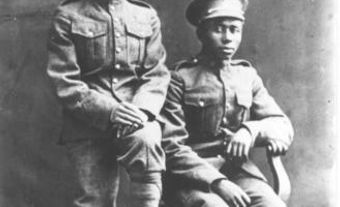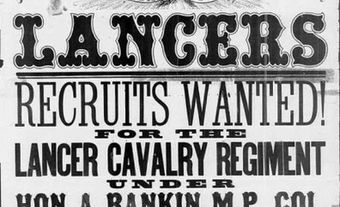Thornton and Lucie (Ruthie) Blackburn, freedom seekers, entrepreneurs, anti-slavery activists and community benefactors (Thornton, born c. 1812 in Maysville, Kentucky; died in 1890 in Toronto, ON. Lucie, born c. 1803, possibly in the West Indies; died in 1895 in Toronto). After a dramatic flight from Kentucky slavery, their recapture in Detroit two years later in 1833 resulted in the Blackburn Riots. Demands for their extradition prompted Upper Canada to establish its first refugee reception policy (see Refugees to Canada). Settling in Toronto, the Blackburns devoted their time and considerable wealth to anti-slavery and African Canadian community causes. (See also Anti-Slavery Society of Canada.) Childless, and having never learned to read or write, their story was nearly forgotten until archaeologists (see Archaeology) unearthed the site of their former home in 1985. The Blackburns’ former property was the first Underground Railroad site ever dug in Canada.
Piecing Together the Blackburns’ Story
In 1985, archaeologists (see Archaeology) working in a downtown Toronto schoolyard unearthed the foundations of a small house, a barn and an earthen root cellar. This had once been the site of Thornton and Lucie Blackburn’s home and business. With support from the Toronto Board of Education, the Ontario Black History Society, and the Ontario government, more than 3,000 schoolchildren and volunteers took part in the excavation. The dig received media coverage around the world and attracted thousands of visitors.
Site director Dr. Karolyn Smardz Frost spent more than two decades piecing together clues to the Blackburns’ remarkable experiences of enslavement and freedom. Her biography of the couple, I’ve Got a Home in Glory Land: A Lost Tale of the Underground Railroad (2007) was the first book on African Canadian history to win the Governor General’s Literary Award for Non-Fiction.

Early Lives
Thornton Blackburn’s tombstone in the Toronto Necropolis states that he was born in Maysville, Kentucky. Maysville is on the Ohio River, which divided the slaveholding South from the free North before the American Civil War (1861–1865). (See also American Civil War and Canada.) Thornton was sold away from his mother when he was only three years old. He was given as a present to the young son of the local postmaster. Forced to work from a young age in the house and stables of the postmaster’s family, he was just 14 when he was sold down the river by a slave trader. Purchased by Dr. Gideon Brown he was taken to Hardinsburg, in central Kentucky.
When the physician died three years later, Thornton was sent to the riverport city of Louisville, Kentucky. There he was hired out to a dry goods company as a porter. Supervised by Dr. Brown’s brother-in-law, Judge John Pope Oldham, Thornton lived in the “quarters” where enslaved people were forced to sleep behind Oldham’s downtown mansion. Thornton’s wages went to help support the doctor’s widow and children.
In Louisville, Thornton fell in love with a beautiful woman. Known as “Ruthie” while enslaved, she was a nursemaid to a white merchant family. Ruthie later said she was a “Creole from the West Indies.” She was 28 years old and Thornton only 19, but she agreed to become his bride. The Blackburns were only happy for a short time. When Ruthie’s owners died suddenly, Mrs. Blackburn was auctioned off to a local merchant who traded enslaved Kentuckians down to the Deep South.
Escape to Detroit
Thornton and Ruthie Blackburn feared that she was destined for the “fancy girl” market in New Orleans or Natchez, Mississippi. Rich Southern men and brothel owners went to these markets seeking mistresses and enslaved sex workers. Ruthie and Thornton made a daring escape by steamboat the day before Independence Day, 3 July 1831. Dressed in fine clothing, they carried forged papers identifying them as free African Americans. The Blackburns traveled north on the steamboat Versailles to Cincinnati, Ohio. There, the couple boarded a stagecoach bound for Michigan Territory. They soon became respected and well-liked members of Detroit’s small African American community.
Trial and Escape to Canada
In June 1833, a traveler from Kentucky recognized Thornton Blackburn on a Detroit street. Reporting his findings to the Blackburns’ respective owners, they sent an attorney and the nephew of the widowed Mrs. Brown arrived in Detroit. The couple were arrested and tried under US federal law as “fugitive slaves.”
Black Detroiters packed the courtroom. Hearing the verdict that sentenced the Blackburns to lifelong bondage, the community vowed to burn the city to the ground should they be sent back to slavery. Thornton and Ruthie were jailed, pending the arrival of the steamboat that would carry them back to brutal punishment, and, undoubtedly, permanent separation from one another.
Meanwhile, their supporters devised a desperate plot. On June 16, 1833, two brave women visited Ruthie in her cell to pray with her before her departure, staying until evening. One changed clothes with the prisoner, taking her place in jail while Ruthie was spirited away across the border to Amherstburg, on the Canadian side of the river.
Thornton’s escape the next day was even more dramatic. When he was brought in chains to the jailhouse door to be taken down to the waiting steamboat, more than 200 armed men and women marched up the street and saved him. Thornton and seven of his rescuers fled across the Detroit River to Sandwich, Upper Canada (now part of Windsor, Ontario). The event, along with further protests in Detroit, became known as the Blackburn Riots of 1833.
In Sandwich, Thornton’s party was promptly jailed, as was Ruthie. The Mayor of Detroit accused them of inciting civil unrest, and the attempted murder of the Wayne County sheriff, who had been badly injured in the melee.
Liberation
Upper Canada’s lieutenant-governor, Sir John Colborne, was no friend of slavery. (See also Slavery Abolition Act, 1833.) When Michigan’s acting governor demanded the Blackburns’ extradition, Colborne asked Attorney General Robert Simpson Jameson to find legal grounds for protecting them. If tried for their supposed “crimes” in an American court, the couple would be returned to Kentucky and slavery. Since enslavement was not a punishment imposed for any crime in British colonial Canada, Colborne ruled that Thornton and Ruthie could not be returned to a jurisdiction where they faced a sentence harsher than Canadian law would allow. This principle remains foundational to Canadian extradition law to this day.
Settlement in Toronto
Ruthie Blackburn changed her name to “Lucie” to mark her newfound freedom. After nearly a year at Amherstburg, she and her husband made their way to Toronto in 1834. There, Thornton discovered his brother, Alfred, who had fled Kentucky slavery five years before. Alfred was working on the city’s eastern outskirts for wealthy brewer Enoch Turner. Lucie and Thornton built a small home on nearby South Park Street (now called Eastern Avenue), just north of today’s Distillery District.
Thornton worked as a waiter at the law courts at Osgoode Hall. He learned that a new kind of public transportation had just arrived in Montreal. This was England’s hackney cab, which seated four and was drawn by a single horse. In 1837, Thornton and Lucie hired mechanic Paul Bishop to build one for them, which they painted yellow with red trim. Just as one might name a boat, they called their cab The City. Memories of the Blackburn cab are echoed in the Toronto Transit Commission’s red and yellow logo colours. The cab stand was located on Church Street to the west of St. James Cathedral . Soon, other cabs owned by different drivers began appearing on Toronto streets.
Thornton and his brother Alfred longed for their mother, Sibby, who was still enslaved in Kentucky. That winter, Thornton returned to Detroit and took the Underground Railroad in reverse, rescuing Sibby Blackburn and carrying her off to Toronto. She lived at Alfred’s east-end house for the rest of her life.
Community Involvement
Thornton Blackburn only ever owned one cab, but his business was very successful. He and Lucie lived modestly and contributed generously to their community and to their city. Lucie Blackburn gave one of the first donations to build Little Trinity Anglican Church. She and Thornton also billeted incoming freedom seekers in their home. It is believed that among their guests was Ann Maria Jackson and her seven children, who fled Delaware enslavement in 1858. The youngest of these children, Albert Jackson, would grow up to become Toronto’s first Black postman.
The Blackburns also built six houses in St. John’s Ward, a downtown neighbourhood where many newcomers first settled Toronto. Thornton and Lucie rented the homes at nominal rates to family after family of freedom seekers.
Thornton was an abolitionist and a delegate to the Convention of Coloured Freemen held at St. Lawrence Hall in September 1851. Delegates came from near and far to discuss how best to respond to the harsh Fugitive Slave Act passed the year before by the US government. Thornton was appointed vice president of the new Canadian Mill and Mercantile Association. Funded by Black businesspeople, it built a sawmill, flour mill and general store to provide jobs at Buxton, a new community for formerly enslaved people near Chatham, in what is now Ontario.
Later Lives
After the Civil War (1861–65), Thornton and Lucie Blackburn retired. (See also American Civil War and Canada.) Thornton’s cab was given to the York Pioneer and Historical Society, which displayed it at Scadding Cabin on Toronto’s fairgrounds. (See also Canadian National Exhibition.) The couple were able to live off the interest of their investments for the rest of their lives. In 1887, the Toronto school board constructed Sackville Street School (now Inglenook Community School) on land expropriated from the back part of the Blackburn property.
When Thornton died in 1890, he left his wife $18,000 — a fortune at that time — and six houses. Lucie sold the old South Park Street property and moved to a house she owned on Bleecker Street, north of Carlton. When she died five years later, Lucie still had $13,000 and an estate including her Bleecker Street home and several mortgages loaned out on properties in St. John’s Ward.
Today, Thornton and Lucie Blackburn rest under a beautiful red granite obelisk in the Toronto Necropolis. Their plot is beside the grave of Globe publisher, abolitionist and Father of Confederation George Brown. Buried with them are Thornton’s mother and brother, Sibby and Alfred, along with lifelong family friend Ann Maria Jackson and her son Richard.
Commemoration
The Historic Sites and Monuments Board of Canada named the Blackburns Persons of National Historic Significance in 1999.
In 2016, George Brown College opened the Lucie and Thornton Blackburn Conference Centre at its first student residence. Including a striking and evocative mural by George Brown College students, this designation commemorates the fact that the Blackburns and George Brown were active in anti-slavery causes at the same time in Toronto.
Key Terms
Extradition A legal process by which someone who has committed a crime, or is suspected to have committed a crime, is handed over to the justice system of the place where the crime was committed.

 Share on Facebook
Share on Facebook Share on X
Share on X Share by Email
Share by Email Share on Google Classroom
Share on Google Classroom















